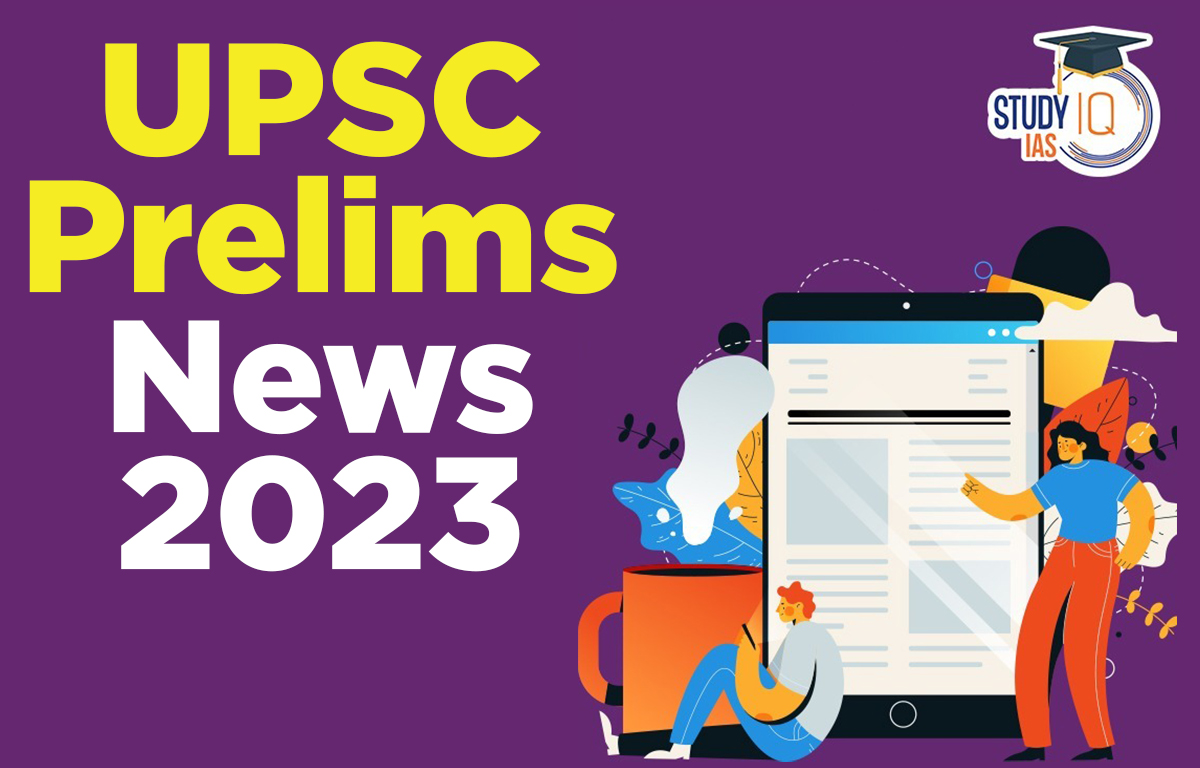UPSC Prelims News of 24 February 2023
22nd Law Commission of India
Context: The Union Cabinet chaired by the Prime Minister, approved the extension of the term of the Twenty-second Law Commission of India up to 2024.
About Law Commission of India
- The Law Commission of India is a non-statutory body, constituted by the Government of India from time to time.
- The Commission was originally constituted in 1955 and is reconstituted from time to time.
- The composition of Law Commission:
- a full-time Chairperson
- four full-time Members (including Member-Secretary)
- Secretary, Department of Legal Affairs as ex-officio Member
- Secretary, Legislative Department as ex officio Member
- Not more than five part-time Members
- The responsibilities of the Law Commission:
- Identification of laws which are no longer relevant and recommending the repeal of obsolete and unnecessary enactments.
- Suggesting enactment of new legislations as may be necessary to implement the Directive Principles and to attain the objectives set out in the Preamble of the Constitution.
- Considering and conveying to the Government its views on any subject relating to law and judicial administration that may be specifically referred to it by the Government.
- Considering the requests for providing research to any foreign countries as may be referred to by the Government.
- Preparing and submitting to the Government, the research undertaken by it.
- Significance: In pursuance of its responsibilities, various Law Commissions have been able to make important contributions towards the progressive development and codification of Law of the country.
Dengue
Context: Peru has declared health emergency over dengue outbreak.
About Dengue
- Dengue fever is a mosquito-borne tropical disease that can provoke a high fever, headache, vomiting, muscle and joint pain, and sometimes death.
- It is a viral infection transmitted to humans through the bite of infected mosquitoes.
- Primary vectors: Aedes aegypti mosquitoes and, to a lesser extent, Ae. albopictus.
- Serotypes: The virus responsible for causing dengue is called dengue virus (DENV).
- Dengue infections are caused by four antigenically distinct serotypes, DENV-1, DENV-2, DENV-3 and DENV-4.
- Severe dengue is a leading cause of serious illness and death in some Asian and Latin American countries.
- Treatment: There is no specific treatment for dengue/severe dengue.
Solar Geo-engineering
Context: Scientists around the world agree that solar geo-engineering technique will be a possible key to tackle global warming.
About Solar Geo-engineering
- Geo-engineering means manipulating the earth’s climate to lower its temperature in a bid to counter global warming.
- Solar geo-engineering (solar radiation modification): It involves cooling the earth by radiating absorbed sunlight back into space.
- It is a subset of geo-engineering.
Idea behind solar geo-engineering
- The temperature of the earth’s surface rises by absorbing heat energy from the sun (short wave radiation).
- The warm surface of the earth emits part of this heat back as infrared radiation (long wave radiation). This outgoing radiation heats the atmosphere.
- Greenhouse gases like carbon dioxide make it difficult for infrared radiation to escape the earth’s atmosphere, causing an imbalance between the incoming and outgoing energies.
- As the total incoming energy exceeds the total outgoing energy, the surface of the earth warms up.
- Solar geo-engineering aims at increasing the amount of heat radiated back into the space using artificial methods.
- This will, in turn, reduce the temperature of the earth’s surface.
Types of Solar Geo-engineering
- Stratospheric Aerosol Injection (SAI): It includes spraying large quantities of tiny particles into the earth’s stratosphere to reflect sunlight and keep the earth cooler.
- Compounds with reflective properties, like sulphur dioxides or finely powdered calcium carbonate, can be used as aerosols.
- Marine Cloud Brightening: It proposes spraying sea salt into low-lying clouds to increase their brightness.
- This could increase the concentration of droplets at the base of a cloud, which in turn will reflect more sunlight before it reaches the surface of the earth.
Anopheles Stephensi
Context: Anopheles Stephensi, a deadly malaria vector from Asia, has been detected in Kenya.
What is Anopheles stephensi?
- Origination: Anopheles stephensi originated in Southeast Asia, West Asia and the Arabian Peninsula.
- It was Africa first reported in Djibouti (2012).
- Since then, this species has been expanding its geographic range in Ethiopia and Sudan, Somalia, and Nigeria.
- Parasites: Anopheles stephensi is capable of transmitting both Plasmodium falciparum and P. vivax malaria parasites.
- Spread: The species is reported to spread faster in different climatic conditions, especially in countries experiencing rapid urban development through devolution, like Kenya.
- Unlike other main malaria-causing mosquito vectors that primarily breed in rural areas, Anopheles stephensi is highly adaptive and can thrive in urban environments.
- Anopheles stephensi exploits several larval habitat types. The habitat types range from human-made water containers such as plastic tanks, cisterns, barrels, discarded tyres and plastic containers, to freshwater pools.
Malaria
- Malaria is an acute illness caused by Plasmodium parasites, which spreads to people through the bites of infected female Anopheles mosquitoes.
- There are 5 parasite species that cause malaria in humans, and 2 of these species: P. falciparum and P. vivax pose the greatest threat.
- P. falciparum is the deadliest malaria parasite and the most prevalent on the African continent.
- P. vivax is the dominant malaria parasite in most countries outside of sub-Saharan Africa.
Chicago Convention
Context: The Union Cabinet has approved the ratification of three Protocols relating to amendments in the convention on International Civil Aviation (Chicago Convention), 1944.
What is the Chicago Convention?
- The Convention on International Civil Aviation, also known as the Chicago Convention was drafted in 1944.
- The agreement laid the foundation for the standards and procedures for peaceful global air navigation.
- It set out as its prime objective the development of international civil aviation in a safe and orderly manner and such that air transport services would be established on the basis of equality of opportunity and operated soundly and economically.
- As of March 2019, the Chicago Convention had 193 state parties, which includes all member states of the United Nations except Liechtenstein.
- The Chicago convention set forth the purpose of International Civil Aviation Organization (ICAO).
- ICAO is a specialized agency of the United Nations linked to Economic and Social Council (ECOSOC).
What are the amendments of the Chicago Convention ratified by the Cabinet?
- Cabinet has ratified the following three protocols relating to amendments in the Chicago Convention:
- Article 3: It refrains member States from resorting to the use of weapons against civil aircraft in flight.
- Article 50(a): It raises the strength of the ICAO Council from 36 to 40
- Article 56: It raises the strength of the Air Navigation Commission from 18 to 21.
What is the significance of ratification of these amendments by India?
- The ratification would affirm India’s commitment to the principles enshrined in the Convention on International Civil Aviation.
- The ratification would also provide better chances and opportunity for India to become more instrumental in matters pertaining to international civil aviation.
Revised Guidelines on MPLADs
Context: Recently, the Minister of State (Independent Charge) of the Ministry of Statistics and Programme Implementation (MoSPI) released the Revised Guidelines on Members of Parliament Local Area Development Scheme (MPLADS)-2023.
About MPLAD Scheme
- The MPLADS is a Plan Scheme fully funded by Government of India, which was announced in December 1993.
- Each year, MPs receive Rs. 5 crore in two installments of Rs. 2.5 crore each. Funds under MPLADS are non-lapsable.
- Objective:
- To enable MPs to recommend works of developmental nature with emphasis on the creation of durable community assets in the areas of drinking water, primary education, public health, sanitation and roads, etc. primarily in their Constituencies.
- Implementation:
- The Nodal District concerned is responsible for implementing the eligible works recommended by the Members of Parliament and maintaining the details of individual works executed and amount spent under the Scheme.
- Functioning:
- Lok Sabha MPs have to recommend the district authorities projects in their Lok Sabha constituencies, while Rajya Sabha MPs have to spend it in the state that has elected them to the House.
- Nominated Members of both the Rajya Sabha and Lok Sabha can recommend works anywhere in the country.
- Special focus:
- MPs are to recommend every year, works costing at least 15 per cent of the MPLADS entitlement for the year for areas inhabited by Scheduled Caste population and 7.5 per cent for areas inhabited by S.T. population.
Revised Guidelines on MPLADs
- The revised set of guidelines aims to broaden the scope of the Scheme so as to enable the MPs to recommend the developmental works as per the changing needs of the community; with an emphasis on improving the functioning, implementation and monitoring of the MPLAD scheme.
- The entire process of fund flow under the revised guidelines will operate through the web portal, which will facilitate real-time monitoring, greater transparency and accountability in the system, and improved efficiency and effectiveness of the MPLAD Scheme.
- The programme consists of training workshop and live demonstration of the role-based features of the web portal, for the officers of the State Governments and Union Territories.
Jaipur Declaration
Context: Recently, “Jaipur Declaration” adopted at the 18th World Security Congress jointly organized by Railway Protection Force and UIC.
About the Declaration
- Jaipur declaration” outlines an actionable agenda for or International Union of Railways (UIC) to explore innovative approaches that can help global Railway organizations achieve their long-term goal of safety and security.
- The conference brought together experts, stakeholders, and delegates from around the world to discuss the latest developments and best practices in railway security, focusing on the theme of “Railway Security Strategy: Responses and Vision for Future.”
- The declaration highlighted the commitment of UIC to work towards providing a more safe and secure rail network across the globe, by also fully activating the Asia-Pacific, Latin America and African regional assemblies by 2025.
UIC
- The UIC (Union International Des Chemins) or International Union of Railways established in 1922 is headquartered in Paris.
- It is the worldwide professional association representing the railway sector for research, development & promotion of rail transport.
- The Security Platform of UIC is empowered to develop and formulate analysis and policy positions on behalf of the global rail sector in matters relating to security of persons, property and installations.
Railway Protection Force (RPF)
- Railway Protection Force (RPF) is the prime security and law- enforcement organization in the field of Railway Security in India, constituted as a federal Force in the year 1957.
- RPF personnel serve the Nation and go the extra mile in their line of duty embodying its tagline “SEWA HI SANKALP”- “A PROMISE TO SERVE”.
Ayushman Bharat Digital Mission
Context: Ayushman Bharat Digital Mission (ABDM) has facilitated Quick OPD registration in 365 hospitals through Scan and Share service.
About ABDM
- Ayushman Bharat Digital Mission (ABDM) was launched in September 2021 with the aims to develop the backbone necessary to support the integrated digital health infrastructure of the country.
- It will bridge the existing gap among different stakeholders of the Healthcare ecosystem through digital highways.
- It aims to provide digital health IDs for all Indian citizens to help hospitals, insurance firms, and citizens access health records electronically when required.
- The project is being implemented in the pilot phase in six States & Union Territories.
- The National Health Authority (NHA) under the Ministry of Health and Family Welfare will be the implementing Agency.
Neutrinos
Context: A study in Japan has failed to find evidence if neutrinos are their own anti-particles.
About Neutrinos
- Protons, neutrons, and electrons are tiny particles that form atoms.
- The neutrino is also an elementary particle, but is not part of the atom. Such particles also exist in nature.
- Neutrinos have a very tiny mass, no electric charge and a half spin. It interacts very weakly with other matter particles and hence difficult to detect.
- Neutrinos are usually produced in high-energy processes such as within stars and supernovae. They are produced by particle accelerators and nuclear power plants on earth.
Applications of neutrinos:
- Medical imaging
- Detecting nuclear proliferation
- Detecting mineral deposits
- Faster global communication
- Inter-stellar communication
Anti-particles
- Every elementary particle has an anti-particle. Both will destroy each other in a flash of energy, if they meet.
- The electron’s anti-particle is the positron, which can be distinguished from each other as they have opposite charges.
- Similarly, neutrinos have anti-neutrinos. However, neither neutrinos nor anti-neutrinos have electric charge, or any other properties to really differentiate them.


 UPSC Prelims News 17 March 2023
UPSC Prelims News 17 March 2023
 UPSC Prelims News 7 March 2023
UPSC Prelims News 7 March 2023
 UPSC Prelims News 1 March 2023
UPSC Prelims News 1 March 2023





















